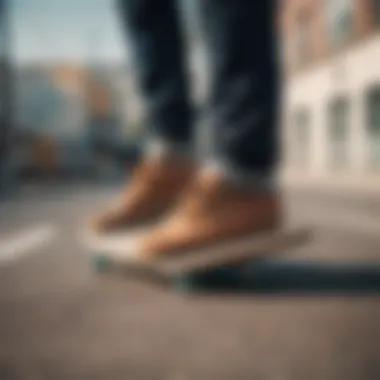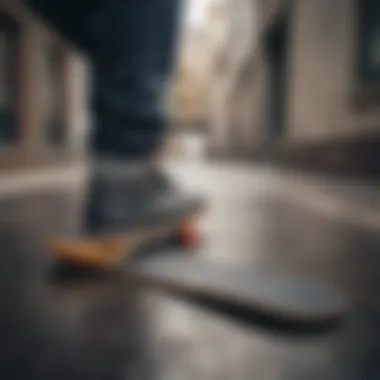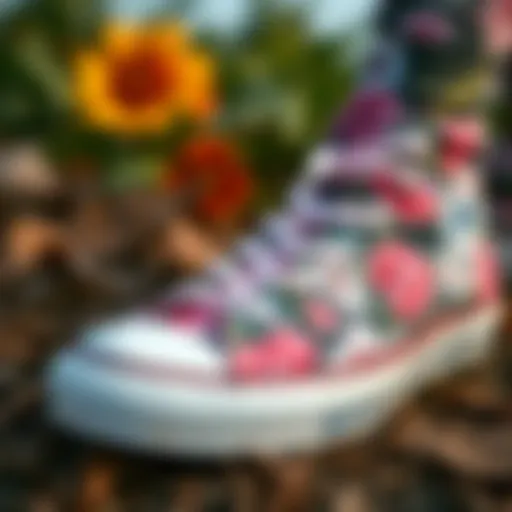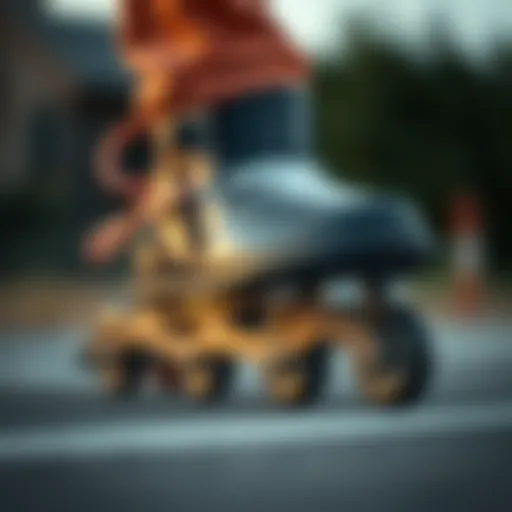The Role of Insoles in Enhancing Vans Slip-Ons for Skating


Intro
When it comes to skateboarding, enthusiasts know that every component of their setup makes a difference, even the most overlooked elements like insoles. Vans slip-ons are a favorite among skaters; they offer a unique blend of style and functionality. However, beneath the cool exterior and iconic waffle soles lies a key factor that significantly impacts comfort, performance, and foot health—the insole.
Insoles are more than just padding; they are crucial for absorbing shock, providing support, and enhancing overall fit. This section highlights why awareness of insoles should be a priority for anyone lacing up their Vans for a session at the local skatepark or a casual ride around town.
Skills Development
While many might focus solely on tricks and maneuvers, a crucial but often neglected aspect is how proper footwear—specifically, insoles—can aid in skill acquisition and development.
Basic Tricks and Techniques
Starting out, it’s common for skaters to attempt basic tricks like ollies, kickflips, and grinds. Each of these demands precise foot placement and good board feel, both of which are greatly influenced by the insoles used.
For instance, a thick, cushioned insole might feel great initially but can hinder your ability to feel the board. Conversely, a thin, firmer insole provides better board feedback, which is particularly useful for beginners still nailing those basic skills. Knowledge about how different insoles affect board feel can propel a skater’s proficiency during practice.
Advanced Maneuvers and Tips
As skaters evolve, they start tackling more complex tricks. Landing a solid tre flip or nailing a Smith grind requires not only skill but also control and balance. Here, the right insole again plays a vital role. A supportive insole can improve balance while absorbing some of the impact during trick execution. This can prevent foot fatigue and longer-term injuries, especially when trying repeated attempts.
One important point worth emphasizing is the consideration of toe and arch support when you are learning to skateboard. If your arches feel tired or cramped, it adds unnecessary distractions while you are trying to focus on your tricks.
Gear and Equipment Reviews
The relationship between gear and performance is undeniable, and insoles, though tucked away in our shoes, fit snugly into this narrative as well.
Skateboards and Accessories
When it comes to combining the right insoles with your skateboard setup, consider that the deck, trucks, and wheels all contribute. A light deck coupled with supportive insoles allows for better energy transfer. If you are serious about your skating, investing in a quality insole can elevate your overall setup.
Safety Gear and Recommendations
Speaking of gear, safety should never be taken lightly. The rise of skateboarding as a sport has led to a myriad of available equipment. Helmet and knee pads are must-haves, but selecting footwear with the right insoles also plays a role in reducing the risk of injuries.
Insoles that offer ample cushioning help in minimizing strains associated with falls, which are part and parcel of learning new tricks. Prioritize comfort and support as you select your skating gear.
When tailored options are available—like custom insoles from companies such as Superfeet or Dr. Scholl's—tailoring your footwear specific to your needs can make a world of difference. A personalized fit could be just what you need to up your game.
"The right insole isn't just about comfort—it's about performance, injury prevention, and ultimately, enjoying your time on the board."
In summary, every component of your skateboarding experience is interconnected. From the insoles in your Vans slip-ons to the skateboard hardware itself, a thoughtful approach to gear selection can propel you from a beginner to an advanced skater with greater ease.
Understanding Vans Slip-On Shoes
Vans slip-on shoes have carved out a notable niche in the world of skateboard footwear. Recognized for their simplicity and ease, these shoes deliver not just style but also practicality for skaters. Understanding the ins and outs of these shoes can significantly impact a skater's performance and comfort. They are often favored for their minimalist design and lightweight construction, which can be appealing for those who prioritize flexibility and mobility during their tricks.
History of Vans Slip-Ons
Vans first introduced their slip-on shoe in the late 1970s as a practical option for skateboarders. Initially deemed "style #98," the slip-on offered an effortless way for skaters to slide in and out while maintaining a strong grip on the deck. Over the years, these shoes have evolved, yet the core essence remains unchanged: comfort and convenience.
What makes Vans stand out is their connection to skate culture. In the 1980s, the shoes gained even more popularity thanks to the rise of skateboarding as a mainstream sport. The lack of laces helped them withstand the harsh conditions skaters faced—an essential for high-action sports. Today, the Vans slip-on continues to be a staple in skateboarding circles and fashion.
Design Features
The design of Vans slip-ons is tailored for those always in action. Their canvas upper provides breathability, allowing air to circulate around the feet, reducing sweat and discomfort. The elastic side accents facilitate easy wear, giving skaters the ability to just jump in and off they go.
Moreover, these shoes typically feature a rubber waffle outsole, providing excellent traction against the board. This specific grip pattern is often cited by skateboarders as a crucial factor for doing tricks, as it helps maintain a strong connection with the skateboard.
It’s also worth noting the variety of colors and patterns available. Skaters can express their personal style while enjoying performance benefits. This mix of form and function is what keeps Vans slip-ons relevant across generations of skaters.
Role of Insoles in Footwear
Insoles play a crucial role in the design and functionality of footwear, especially in performance-driven shoes like Vans Slip-Ons. They are the unsung heroes that contribute to overall comfort, stability, and protection for skaters as they navigate tricks and landings. A well-constructed insole can transform a simple shoe into a performance powerhouse, enhancing every aspect of riding.
Not only do insoles provide cushioning, but they also help support the arch of the foot and reduce the strain on joints. This is where the right insole can make a world of difference—without them, skaters might face discomfort and fatigue that can detract from their overall experience.
Function of Insoles
The primary function of insoles is to provide cushioning and support. For skateboarders, this means absorbing shock upon landing and protecting the feet from impacts. A good insole can help distribute weight evenly across the foot, alleviating pressure points that can lead to pain and fatigue when riding for extended periods. Whether you’re doing ollies or grinding rails, your insoles support every jump and maneuver you make on the board.
Compression resistance and shock absorption are key characteristics that define how effective an insole can be. The right insole will adapt to the contours of your foot while maintaining enough firmness to provide stability during fast movements and sudden stops.


Types of Insoles
Insoles come in various types, each offering distinct benefits tailored to different skating styles and needs. Understanding the nuances between them can empower skaters to make informed choices that enhance their experience.
Foam Insoles
Foam insoles are widely popular due to their adaptability and comfort. One major advantage of foam insoles is their lightweight nature; they are often made from materials like EVA (ethylene-vinyl acetate) or PU (polyurethane), which provide great cushioning without adding excessive bulk.
Key characteristic of foam insoles is their shock-absorbing properties. This feature helps minimize the impact during landings, making them a sought-after choice for skaters who frequently execute high jumps or tricks. Additionally, foam insoles conform to the shape of your foot, offering customized comfort that can be especially helpful during long skating sessions. However, it’s good to note that while foam insoles are durable, they might wear down faster than other options, especially with daily use.
Gels
Gel insoles provide a different approach to comfort and support by incorporating a viscous gel material. This feature allows for excellent shock absorption, making them especially beneficial for preventing heel impacts when landing tricks. The key advantage of gel insoles lies in their ability to retain shape even after prolonged use, which can lead to extended periods of comfort.
Moreover, many skaters appreciate how gel insoles offer a slippery feel, which can aid in responsiveness while riding. They can also provide a lovely blend of support and cushioning, acting like a small trampoline for the foot. On the downside, gel insoles may retain heat, which could be a discomfort in warmer weather.
Orthotic Options
Orthotic insoles take a more specialized approach, often tailored to address specific foot issues such as overpronation or high arches. These insoles are typically designed with extra support in mind, offering proper alignment and guidance for the foot. The key characteristic of orthotic options is their customization—some orthotics can be molded to the unique shape of the wearer’s foot.
Using orthotic insoles can lead to significant benefits, especially for skaters with pre-existing foot problems or those engaging in long sessions. They can assist in pain relief, ultimately allowing for better performance and enjoyment while skating. However, the cost of custom orthotics can be higher compared to other insole types, compelling some skaters to weigh the benefits against their budget.
Impact of Insoles on Comfort
When it comes to skateboarding, comfort can make or break your ride. The insole—that often overlooked piece of foam or gel—is a critical part of the equation. It's what stands between your foot and the demanding surface of the board, absorbing shocks and alleviating certain types of pain. Understanding this is key, especially for those long skating sessions where your body endures pressure, weight, and motion.
The primary function of insoles relates to how they enhance your overall comfort. Whether you’re doing tricks or simply cruising, the right insoles can play a crucial role in maintaining foot health while improving performance. This section dives into the specifics of how insoles achieve this through cushioning and shock absorption, and how adequate arch support contributes to a good overall experience.
Cushioning and Shock Absorption
Cushioning is the magic word when it comes to insoles. Particularly for skateboarders, the impacts from landing tricks can take a serious toll on feet, ankles, and knees over time. A well-cushioned insole can absorb much of that shock, allowing for a softer landing on the board. Notably, materials like memory foam and gel are commonly employed in making insoles for Vans slip-ons. They excel at distributing weight evenly, reducing pressure points on the foot.
The importance of having good cushioning cannot be overstated:
- Allows greater endurance without discomfort.
- Enhances agility, keeping your feet nimble.
- Reduces fatigue during extended skating, letting you push your limits.
Moreover, a few brands offer insoles that adapt to the heat of your foot, molding to your unique foot shape as you skate. This personalized fit guarantees maximum comfort, making your Vans slip-ons an extension of yourself on the board. It’s like having your own piece of tech that responds to your every move.
"Good insoles are as critical as your board. They absorb shocks and keep your feet in peak shape for the day ahead."
Arch Support
Just as important as cushioning is arch support. Each skateboarder has a unique arch type, whether it’s flat, neutral, or high. This variation significantly affects how forces are distributed through the foot during skating. Without adequate arch support, a skater may run the risk of experiencing pain or discomfort after a short period.
Optimal arch support does multiple things:
- Stabilizes Natural Movement: It guides your foot in its natural motion, minimizing stress on ligaments and joints.
- Enhances Balance: A well-supported arch means more control over your board, especially during flips and turns.
- Prevents Fatigue: Long sessions can lead to tired feet; proper arch support can push back against that fatigue.
When selecting insoles for your Vans slip-ons, be mindful of this factor. Different insole types cater to various arch forms, allowing you to customize your comfort based on your foot’s anatomy.
In summary, investing in quality insoles that prioritize cushioning and arch support can enhance your skateboarding experience immensely. Not only will your feet thank you for it, but your performance will likely improve as well. This brings us to the next critical aspect of insoles: their role in performance enhancement.
Performance Enhancement Through Insoles
In the fast-paced world of skateboarding, every element of your setup matters, down to the insoles in your Vans slip-ons. The right insole can substantially elevate performance, offering advantages that go beyond mere comfort. Think of insoles as the unsung heroes of skateboarding; often overlooked, yet pivotal to a rider's success on the board.
Improved Grip on Board
When you're on a skateboard, maintaining grip is essential to executing tricks with precision. Insoles can dramatically impact how your foot connects with the board. Specialized insoles develop friction and stability, providing the much-needed grip to keep your feet locked in place during those gravity-defying maneuvers.
Consider insoles made from rubberized materials or features like embossed textures. These enhancements prevent slipping, allowing skaters to push their limits without the fear of losing control on the board. One skater described it well, saying that “like having glue on my shoes,” highlighting how vital insoles can be for enhancing performance. The right choice can mean the difference between landing flawlessly or eating pavement.
"The grip on my board improved tenfold once I switched to a high-quality insole," mentioned one skateboarder on a forum.
Insoles that cater specifically to skateboarding needs can offer various thickness levels to accommodate personal preference while still providing that vital traction. Keep an eye out for brands focusing on skater-specific designs when choosing your insoles.
Response Time and Control
It’s not only about grip; response time is equally crucial when it comes to perfecting your tricks. Insoles that are designed with responsiveness in mind can convert the board's movements into real-time reactions from the skater. This means that every shift, every nudge, and every flick of the board feels more immediate and connected.
Consider an insole that utilizes a mix of foam and gel, offering just the right bounce and support. This can enhance your ability to make split-second judgments, whether that's repositioning mid-air or adjusting your balance when you land. The feedback on the board feels more direct, almost as if your feet are communicating with the skateboard itself, allowing for a graceful fluidity during performances.
For instance, skaters often rave about the added control they gain from using insoles with specific arch support features. Such designs not only aid in energy transfer but also help maintain proper foot alignment, reducing the fatigue that can come from extended riding.


In summary, insoles can significantly affect how a skater performs. Particularly for those navigating street and vert styles, where each second counts, the right insole can create a seamless partnership between you and your skateboard. Embrace this often-overlooked component of your gear; after all, it's the finer details that enable those standout performances.
Long-Term Foot Health Considerations
When it comes to skateboarding, your foot health can't be an afterthought. The right insoles in your Vans slip-ons play a crucial role in shaping not only your immediate comfort but also your long-term athletic health. It's not just about landing that sweet trick; it's about ensuring your feet are up for the challenge today and years down the line.
Preventing Injuries
Skateboarding is a rugged sport. Each grind, ollie, and ramp landing puts a jumpy strain on your feet and ankles. By using specially designed insoles, you can mitigate those risks significantly.
Consider this: a decent pair of insoles can be like a good bodyguard, keeping unwelcome injuries at bay. For instance, soft yet supportive insoles can help absorb shock during high-impact landings, preventing stress fractures and sprains. Additionally, they offer better alignment for your feet, promoting a neutral posture that keeps undue pressure off vulnerable areas.
- Enhanced Shock Absorption: Good insoles can absorb the impact associated with skateboarding moves, reducing the likelihood of injuries.
- Increased Stability: This stability can help skaters maintain their balance, thereby lowering the chances of falls that lead to injuries.
- Adaptability: Over time, a customized insole can mold to the unique contours of your foot, offering personalized protection that evolves with you.
Joint Impact and Pain Relief
The joints in your feet, especially the ankles and knees, take quite the beating when skateboarders perform tricks. Insoles serve as the cushioning layer to lessen this impact, helping reduce the wear and tear that can lead to chronic pain over time.
If you've ever experienced that nagging ache from your heels up to your toes after a long day of skating, then you know how vital comfort is. By choosing the right insoles, you can significantly improve your comfort levels:
- Arch Support: Proper insoles help maintain the natural arch of your foot, which can alleviate strain on your knees and hips.
- Pain Management: Many insoles include gel or foam construction that targets specific pressure points, providing relief from the jolts that come with hard landings.
- Preventative Approach: Investing in good insoles is like having an insurance policy for your feet. The earlier you start, the better the odds are that you’ll sidestep long-term pain issues.
"Investing in the right insoles for your Vans can make a significant difference not just while you skate, but in how your feet feel long after you’ve put them on the board."
Remember, your feet are your foundation. They need to endure the grind and wear of each ride. Choosing the right insole isn't merely an accessory; it's a vital component of your skating like the board itself. By keeping your foot health in check, you can skate harder, longer, and with more confidence.
Selecting the Right Insole
Choosing the right insole for your Vans slip-ons can feel like searching for a needle in a haystack when you're drenched in options. However, this decision might very well impact your skating game more than you'd think. Understanding your foot type, skating style, and personal preferences can guide you in making an informed choice. Each of these factors bears weight in terms of comfort, performance, and even injury prevention. If you care about your feet and want them to support your efforts on the board instead of holding you back, then putting thought into this selection is key.
Factors to Consider
Foot Type
The type of foot you have is not just some technical jargon; it plays a pivotal role in determining the kind of insole that will work for you. Let's break it down.
- Flat Feet: For those who have flat arches, insoles with solid arch support are a godsend. A cushy insole can provide just the right lift to your foot, giving it a comfortable resting place while you skate.
- High Arches: People with high arches may benefit from softer, more padded insoles that can help provide cushioning during landings.
Identifying your foot type not only prevents discomfort but also contributes to enhanced balance and stability while performing tricks. Missing the mark here could lead to unwanted pressure points, which no skater wants to deal with.
Skating Style
Whether you’re a street skater pulling off tricks in urban jungles or more of a vert skater aiming for the skies, your skating style influences what you should look for in an insole.
- Street Skating: These skaters often require insoles offering superior board feel and thin profiles. Having that direct contact can help in executing tricks like flips and shuvits with precision.
- Vert Skating: Skaters who are more inclined to aerial tricks may need extra cushioning and shock absorption. The impact from landing jumps can be significant, and a well-cushioned insole provides much-needed support.
Understanding your skating style helps you choose an insole that nurtures not just comfort but also boosts your confidence when hitting those difficult tricks.
Personal Preferences
Last but certainly not least is your own personal flair. Not everyone skates the same, and neither should everyone use the same insoles.
- Comfort vs. Control: Some prefer soft insoles that cradle their foot, while others want a firmer feel that gives them greater control over their board.
- Material Choice: Whether you lean towards foam or gel, each material offers unique characteristics. Foam might feel great at first, but you could appreciate the resiliency and longevity of a gel insole more in the long run.
Your personal choice can shape your overall skating experience. A mismatch here may lead to frustration instead of the thrilling enjoyment you seek.
Custom Insoles vs. Store-Bought Options
When it comes down to it, you're often faced with a choice between custom insoles and the ready-to-go store-bought options.
- Custom Insoles: These are tailor-made for your feet, aiming to address all those little quirks and idiosyncrasies that off-the-shelf insoles might overlook. They can be especially beneficial if you have specific foot needs that warrant such attention. Though, let’s be real, they can be pricier, and not everyone is willing to dish out that cash.
- Store-Bought Options: On the other hand, you have flexible, budget-friendly choices that cater to a wide array of foot types. Finding the right pair might take some trial and error, but the world of basic insoles is vast and varied.
Caring for Your Insoles
When it comes to maximizing the benefits of insoles in Vans slip-ons, caring for them is crucial. Just like any other piece of equipment, proper maintenance can extend the lifespan of your insoles, ensuring that they remain effective in providing comfort and support while you skate. Without routine care, insoles can become less effective, leading to discomfort and potential injuries while performing.
Cleaning and Maintenance
Keeping your insoles clean not only improves hygiene but also helps maintain their structure and effectiveness. Here are some practical tips:
- Regular Cleaning: Give your insoles a good cleaning at least once every few weeks, especially after intense skating sessions. Utilize mild soap and warm water, scrubbing gently with a soft brush to dislodge dirt and odors.
- Air Drying: Never throw your insoles in the dryer. Instead, let them air dry at room temperature to prevent warping or damage to the material. Direct sunlight can be harmful, so keep them in a shaded area.
- Check for Deterioration: While cleaning, keep an eye out for signs of wear. Look for cracks in foam or materials breaking down. This can signify that your insoles are nearing the end of their usefulness.
Tip from the pros: "Keeping your insoles dry and clean can prevent bad odors and help maintain optimal support when you’re on the board."


When to Replace Insoles
Knowing when to replace your insoles is just as important as maintaining them. Here are some signs that may indicate it’s time for an upgrade:
- Visible Damage: If you notice cracks or significant wear, replacing the insoles is a must to avoid foot discomfort.
- Loss of Cushioning: If it feels like stepping on a hard surface rather than the usual comfort, that’s a telltale sign that the cushioning has degraded.
- Persistent Discomfort: Difficulty or pain after skating can indicate that your insoles aren’t providing the necessary support anymore.
- Foul Odor: Sometimes, insoles can absorb sweat and get stinky; a persistent odor may mean they need to be swapped, even if they look good.
In short, keeping an eye on your insoles and caring for them can ensure they serve you well on longer rides and challenging tricks. Paying this type of attention to your gear can make a world of difference, giving you the edge and comfort you need as you push your skating skills to new heights.
Comparative Analysis of Insoles
When it comes to choosing the right insole for Vans slip-ons, skateboarders often find themselves weighing the benefits of various materials and designs. Contrasting the pros and cons of different insoles is not merely an academic exercise; it’s about finding what enhances your skating experience. A proper insole can spell the difference between a smooth ride and a torturous one.
Pros and Cons of Different Materials
Skateboarders should consider insole materials like foam, gel, or even orthotic options, as each comes with its unique set of advantages and drawbacks.
- Foam Insoles: These are among the most popular due to their affordability and comfort. Often made from materials like EVA foam, they conform to the foot’s shape and provide decent cushioning. However, they may lack durability and can wear down quicker than other types, resulting in less support over time.
- Gel Insoles: Known for their excellent shock absorption, gel insoles provide a plush feel that skaters appreciate during intense landings. However, while they are comfortable, some users find them to be a bit bulky. This extra height can sometimes affect the fit of the Vans slip-on and the board feel.
- Orthotic Options: For skateboarders with specific foot conditions, custom orthotic insoles can offer unparalleled support. They’re designed to align the foot correctly and are often molded to individual feet. However, they come at a premium price and might take some time to break in.
Understanding these materials helps skaters choose wisely to suit their unique skating styles and foot needs.
Performance Metrics
In evaluating insoles, certain performance metrics shine a light on how well an insole can contribute to a skater’s overall experience. The three key aspects to consider are durability, flexibility, and weight.
Durability
Durability is vitally important when skateboarding, as skate shoes take a beating. The right insole should withstand rough use without compressing too quickly. A durable insole retains its structural integrity over time, keeping support consistent. One key characteristic of durable insoles is their resistance to wear and tear; materials like polyurethane are a smart choice for long-lasting performance. While more durable insoles might come with a slightly higher price tag, their longevity makes them a wise investment for serious skaters who want to avoid frequent replacements.
Flexibility
Flexibility plays a crucial role in how a skater feels on their board. A flexible insole allows for natural foot movement, which is critical for tricks and turns. Insoles that strike a balance between support and give are often a preferred choice. Skateboarders typically dislike insoles that are too rigid, as this can hinder performance. The most beneficial feature of flexible insoles is their ability to adapt to the foot’s natural movement, ensuring both comfort and responsiveness—essential for executing tricks effectively.
Weight
The weight of an insole can impact overall performance and comfort. Lightweight insoles enable better board feel, allowing skaters to move with agility. A heavy insole can feel cumbersome and limit foot responsiveness. The ideal insole often combines lightweight materials with enough cushioning and support. Less weight translates to agility, which is vital for advanced skateboard maneuvering. A common choice among skaters seeking to maintain that featherweight feel is using thin, yet well-cushioned, insoles.
User Experiences and Testimonials
User experiences and testimonials play a crucial role in understanding the impact of insoles in Vans slip-ons, especially for skateboarders. When you’re on a board, comfort isn’t just a luxury—it's essential for performance. Hearing directly from those who have tested various insoles can provide insights that are often overlooked in technical specifications or product descriptions. Real-life experiences can shed light on how certain features translate into the daily grind of skating.
Feedback from skateboarders comes from diverse backgrounds, and they often share relatable stories that many can connect with. These testimonials can help future buyers avoid common pitfalls and head straight to the best options available.
Skateboarders’ Feedback
Skateboarders frequently express their thoughts regarding their specific choices of insoles. For instance, some users rave about the added cushioning from gel insoles, which they claim transforms their riding experience. They mention how the right innersole makes their Vans slip-ons feel like they are part of their foot rather than a separate item.
A common theme in testimonials is the emphasis on comfort during long hours of skating. Some skaters have noted incidents where they felt fatigue was significantly reduced when they switched to higher-quality insoles. Another frequent piece of feedback revolves around the balance between thin profiles in their slip-ons, which contributes to better board feel, and adequate cushioning that absorbs shock and prevents injury.
Influence on Performance
The performance aspect of insoles in Vans slip-ons cannot be ignored. Testimonials from seasoned skaters illuminate how different insole materials can affect performance nuances like grip, control, and overall balance on the board. Many users testify that the right insole can amp up their confidence when attempting tricks or riding at speed.
"Switching to a custom orthotic made a world of difference for me. I felt more stable on my board and could land tricks without worrying about foot fatigue."
— A local skatepark regular.
When a skateboarder feels physically supported, they can push their limits. This newfound stability allows skaters to perform at their peak, showcasing their skills without the nagging distraction of discomfort. Consequently, the feedback suggesting that greater confidence leads to better attempts supports the idea that investing in quality insoles is not just about comfort, but also about enhancing performance.
In conjunction with personal narratives, studies show that insoles influencing biomechanics can ultimately improve foot alignment and reduce injury risk during high-impact activities like skateboarding. As such, testimonials from skateboarders underscore the importance of insoles as a pivotal part of their performance equation.
Future Trends in Footwear Technology
The ongoing evolution in footwear technology is taking center stage, especially in the realm of skateboarding shoes. This trend is not merely about aesthetics; it has significant implications for comfort, performance, and foot health. In the context of Vans slip-ons, understanding future trends can be invaluable. Whether you’re a skater pushing the limits or a casual wearer, these advancements can shape your experience on and off the board.
Innovative Materials
The quest for better performance has ignited a surge in innovative materials tailored for skateboarding insoles and shoes alike. Manufacturers are now adopting cutting-edge textiles and compounds that enhance durability without sacrificing flexibility.
- Lightweight Composites: These blends offer robustness while keeping the overall weight of the footwear down. For skateboarders, every ounce matters. A lighter shoe can mean better agility and control.
- Moisture-Wicking Fabrics: Managing sweat and keeping feet dry is essential—especially when performing tricks. Materials designed to wick moisture away help in preventing blisters and maintaining comfort.
- Eco-Friendly Options: More brands are now investing in sustainable materials. Skateboarders who value environmental responsibility can find options that not only perform well but also contribute to a greener planet.
The shift toward these materials highlights a broader trend where skaters can benefit from both performance enhancements and more responsible manufacturing practices.
Smart Insoles and Wearable Technology
The integration of technology into insoles is no longer a distant dream but a growing reality. Smart insoles are designed with functionalities that revolutionize the way skateboarders interact with their equipment.
- Activity Tracking: Some insoles can monitor your movements, providing essential metrics on performance. This data helps you understand your skating habits and areas for improvement.
- Real-Time Feedback: Imagine an insole that can communicate with your smartphone, delivering tips on foot placement or suggesting exercises to enhance strength. This level of interaction can elevate your practice sessions.
- Pain Management: Advanced smart insoles might include sensors to detect discomfort or incorrect posture, prompting you to adjust before a more significant injury occurs.
"Technology in footwear isn't just about looking cool; it's about feeling better and performing at your best."
By paying attention to what the future holds, skateboarders can make informed choices, optimizing their gear to suit their unique skating style.







